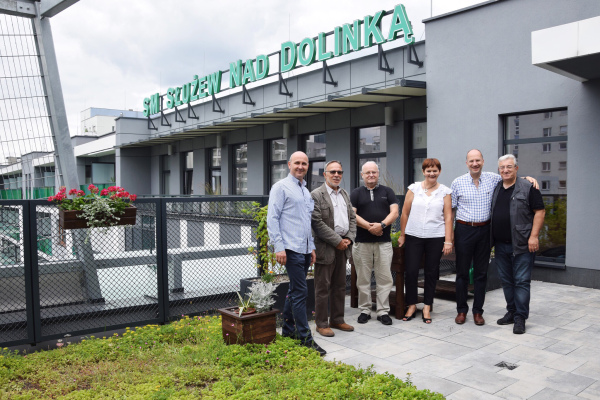UK co-operators have been taking fact-finding tours of housing co-ops in other countries. While these countries have different legal and regulatory environments, their co-ops share a commitment to building strong communities.
Nic Bliss in Canada
Nic Bliss, head of policy at the Confederation of Co-operative Housing (CCH) is currently in Canada, where the co-op housing sector is starting to build new homes. His six-week study visit is being funded by the Winston Churchill Memorial Trust.
“The co-operative sector in Canada, which includes 2,000 housing co-ops, is very similar to the one in the UK,” writes Mr Bliss on his blog.
With an average of 42 homes per co-op, the sector is made up of small community organisations largely focused on affordable homes for people on low incomes.
In 2016, members of the Co-operative Housing Federation (CHF) of Canada passed a motion to kick-start the development of new homes. The initiative is backed by a federal housing strategy providing resources for new homes.
Mr Bliss began his tour at the CHF annual meeting, where he heard from Selina Robinson, British Columbia’s minister of municipal affairs and housing, and federal MP Adam Vaughan. British Columbia plans to build 5,000 new co-operative homes over the next four years. Another opportunity for the sector is the recently launched National Housing Strategy, supported by C$40bn over 10 years, including the C$13bn Co-Investment Fund.
Next was Vancouver, where Mr Bliss looked at the work of the Community Land Trust in developing new co-ops and regenerating and supporting existing ones.
“Their achievements are inspirational. Seven hundred new co-operative homes and a further 1,900 co-operative homes in the pipeline speaks for itself. These are the sorts of targets we need to be setting in the UK,” he wrote.

One of the co-ops developed, the 84-home First Avenue Athletes Village Housing Co-op is a community with members drawn from a range of income levels. Facilities include extensive meeting spaces, a roof garden, laundry rooms, a library and a communal kitchen space.
In Calgary, the Sunnyhill Housing Co-op provides 66 homes. Developed in 1978 in the city centre area through local activity, the co-op has attracted families, kept the local school open and maintained the community. Mr Bliss explains how, as in the case of the other co-ops, there is a strong community feel within Sunnyhill – while the structure also enables families to continue to live in an area where ordinary people are priced out.
And in Winnipeg, Old Grace Housing Co-op developed a scheme requiring market share payments between C$72K and C$133K against each of the homes, with 34 homes subsidised through Manitoba Province to bring share payments down to C$17K.
“With this still being unaffordable for those on low incomes, various foundations and churches further sponsor share payments for 4 x 4 bedroomed properties, currently lived in by refugee families,” says Mr Bliss.
“But Old Grace is already a vibrant community, with gardening, a fitness group and other activities organically forming; wonderful community facilities designed to encourage interaction; and members showing warm appreciation for those on the development group at a recent packed members meeting.”
In Ontario, Mr Bliss met with members of student housing co-ops from NASCO, a federation of student housing co-operatives in Canada and the United States, and WCRI, one of the largest student housing co-operatives in North America, housing 700 resident members. WCRI has recently developed a further 160 bed spaces, with 208 more planned by the members’ redevelopment committee.
“These achievements are particularly impressive given that this development has been entirely self-funded,” he said.
Mr Bliss will continue his journey to Ottawa and Quebec City. Updates from his trip can be followed through his blog posts on CCH’s website.
Blase Lambert in Estonia
CCH chief officer, Blase Lambert, travelled to Estonia in June to attend a board meeting of Co-operative Housing International, a sectoral organisation of the International Co-operative Alliance, of which he is a treasurer. The meeting coincided with the AGM of Housing Europe, the European Federation of Public, Cooperative & Social Housing.
Mr Lambert learnt about the history of the co-operative housing movement in Estonia, where the housing market and legal and regulatory environment are different from the UK’s. The demand for new housing is not as high as in the big western cities; home ownership is high at 81.5%, with 65% of people living in apartment buildings and 95% of apartments in private ownership. However the majority of these are not insulated or ventilated.

Formerly part of the USSR, Estonia regained its sovereignty in 1991. As in other former USSR and Eastern Bloc countries, the housing stock was handed over to individual residents – a move that resulted in a great number of flats where residents owned the flats but with nobody responsible for the exterior of the building or its maintenance. As a result, legislation was passed requiring that the management of communal parts be run by co-ops or housing associations. Almost 60% of the total population in Estonia belongs to a housing association or co-op. The individuals maintain ownership of the flats but the communal area is managed based through the co-ops or associations.
Mr Lambert says this approach enables the co-ops to make improvements to buildings and raise environmental standards.
The Estonian Union of Co-operative Housing Associations includes 1,400 co-operative housing and apartment associations, being the largest housing association in the country. As well as representing these, the Union runs training for over 5,000 people every year. Housing managers – a new profession in Estonia – also undertake courses licensed by the Ministry of Education. Decisions within the co-ops are taken at general assembly meetings using a simple majority 50% +1 rule.
“People’s perception has changed in Estonia because of the advances achieved and improvements made to the buildings,” said Mr Lambert. “They see housing co-ops as something that can raise standards, and drive energy efficiency programmes, rather than a vehicle of Stalinist state. So there is a really positive attitude around co-operation and housing in Estonia.”
The regeneration projects benefited from €38m in funding through EU grants, with total investment of €135m coming from the EU, the Estonian government and private finance. Around 663 apartment buildings out of the country’s 20,000 have been renovated so far, with average energy savings per building of 43%.
The exchange was an opportunity to get to know the Estonian housing co-op sector and understand how people operate, says Mr Lambert.
“It is similar to what we have in the UK but much more advanced. Here we provide day-to-day services via co-ops, where as there they expanded it into major works and improvements to the building,” he added.
Secretary general of Co-operatives UK, Ed Mayo, was recently in Poland, where he attended a board meeting of Cooperatives Europe, a regional office of the ICA.
He also visited Sluzew Nad Dolinka (SND) housing co-op, south of Warsaw. The country is home to over 3,500 housing co-operatives. Set up in 1991, SND runs an area of forty-two hectares, with 42 buildings housing ten thousand people.
Writing about the journey on his blog, Mr Mayo explained how the co-op was placing a strong emphasis on sustainable living. He says the air in the neighbourhood is the cleanest on official data of any quarter around Warsaw. Furthermore, people can grow fruit and vegetables in dedicated spaces and flowers on the balconies.
Around 59% of the area owned by the co-op is green while the roof of the most recent development has beehives. While equipped with CCTVs, the housing co-op is one of the safest estates in the region, based on police statistics.

“There was a sense of buzz and fun in the co-operative, which spoke to the involvement that people clearly had in their home, both housing and green space. There was also a sense of pride. Throughout the estate, there were tributes erected on the vote of members that spoke to what connected them, including one to mark Poland’s (95 and then, this year) 100 years as an independent nation,” Mr Mayo told Co-op News.
Mr Mayo also received a medal from his counterpart Mieczyslaw Grodzki as a friend of the Polish co-operative movement.
The Polish government has introduced legislation that allows for the demutualisation of housing co-operatives. However, in most cases, members chose to stay with the co-op. “Housing co-ops remain a powerful force in Polish life and a key asset in a strong, wider co-operative sector,” says Mr Mayo.